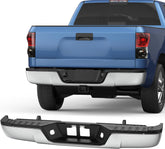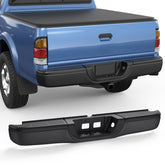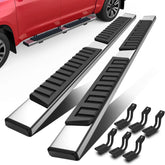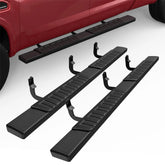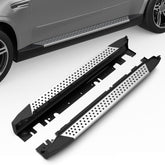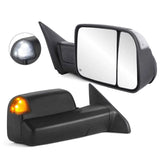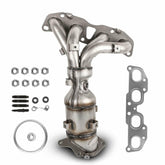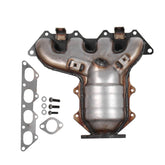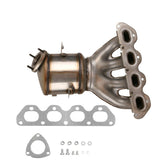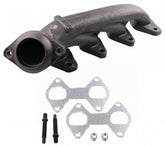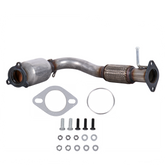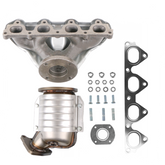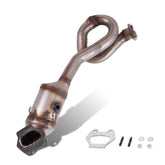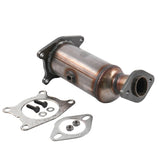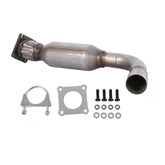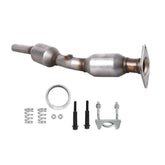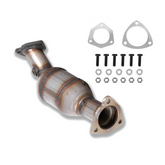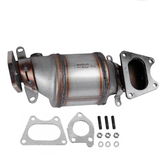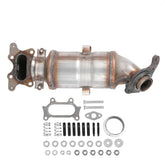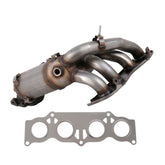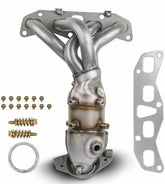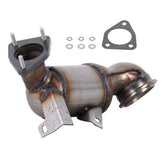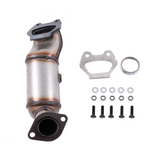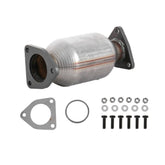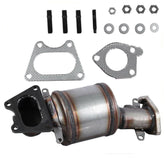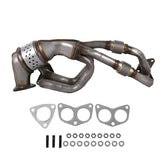Filter
23 results
20
- 10
- 15
- 20
- 25
- 30
- 50
Best selling
- Featured
- Best selling
- Alphabetically, A-Z
- Alphabetically, Z-A
- Price, low to high
- Price, high to low
- Date, old to new
- Date, new to old
Sort
Sort by:
- Featured
- Best selling
- Alphabetically, A-Z
- Alphabetically, Z-A
- Price, low to high
- Price, high to low
- Date, old to new
- Date, new to old
-
Manifold Catalytic Converter w/ Gasket Kit For 2007-2012 Nissan Altima L4 2.5L 753006Vendor: MOSTPLUS1 YEAR WARRANTY Features · Tube material: Aluminized Steel· Exchange part number:674-933· Parts Numbers: 140E2-ZX31E 140E2-JA02E 140E2ZX31E 140E2JA02E· EPA OBD-II Approved.· Best Quality as OEM Style Replacement.· Manufactured From High Quality & Durable Stainless Steel Catalytic Case For Long Lasting Durability & For...
- $139.99
$149.99- $139.99
- Unit price
- / per
-
Exhaust Manifold Catalytic Converter +Gasket For 02-07 Mitsubishi Lancer L4 2.0LVendor: MOSTPLUSONE YEAR WARRANTYFeatures 100% Brand new High flow design to provide more oxygen to your engine for an increase in power and performance. Fully tested under extreme condition for heat resistance and long-life use. Including Gaskets & hardware (Showing as the picture) Interchange Part...
- $137.99
- $137.99
- Unit price
- / per
-
Exhaust Manifold Catalytic Converter w/ Gasket For Chevy Cruze Sonic 4-Door 1.8LVendor: MOSTPLUSONE YEAR WARRANTY Features Condition: 100% brand new OE# 674-841 Restricted States California, New York, Maine Certification EPA Feature EPA OBDII APPROVED Gasket Included Yes Material Steel and Ceramic Mounting Hardware Included No Oxygen Sensor Location Post-Catalyst Connection Type 3 Bolt Engine Size 1.8L/1.6L Fitment Type...
- $192.99
- $192.99
- Unit price
- / per
-
Right Side Exhaust Manifold Kit For Ford Expedition F150 F250 F350 Truck V8 5.4LVendor: MOSTPLUS1 YEAR WARRANTY Features Direct replacement Replaces dealer part number: 3L3Z-9430-DA, 7C3Z-9430-A, 3L3E-9430-DA, 3L3E-9430-DA, 7C3E-9430-DA, 7C3E-9430-DA, 3L3Z9430DA, 7C3Z9430A, 3L3E9430DA, 3L3E9430DA, 7C3E9430DA, 7C3E9430DA Corrosion resistant Strengthened and redesigned in the vulnerable areas of failure Built to strict quality control standards Includes Exhaust manifold Gaskets...
- $69.99
- $69.99
- Unit price
- / per
-
Catalytic Converter For 2010-2014 Chevy Equinox GMC Terrain 4-Door 2.4L 54850Vendor: MOSTPLUSDetails: Brand: MOSTPLUS Warranty: 1 Year Surface Finish: Stainless Steel Catalytic Converter Body Mounting Hardware Included: Yes Labels & Certifications: EPA Fitment Type: Direct Replacement Placement on Vehicle: Front Features Condition: 100% brand new Interchange Part Number: 50508, 54850, 19463, 51804,12609823, 327-00277, 327-02280, 327-02317...
- $131.99
- $131.99
- Unit price
- / per
-
Front Exhaust Manifold Catalytic Converter Kit For 1996-2000 Honda Civic 1.6LVendor: MOSTPLUSFeatures:· Brand New· Interchange Part Number: 2109-248024, 6002826, 099-884,674439, M327221,18160P2EA10Fitment:For 1996-2000 Honda Civic 1.6LNOTE:Due to state emissions regulations, we cannot ship this item to the state of California as it is not C.A.R.B ( California Air Research Board) approved for use in this state....
- $138.99
$145.61- $138.99
- Unit price
- / per
-
Front Left Manifold Catalytic Converter w/Gasket 53988 641511 Compatible with 2012-2017 Jeep Wrangler 3.6LVendor: MOSTPLUSFeatures: 100% Brand new Brand: MOSTPLUS Warranty: 1 Year High flow design to provide more oxygen to your engine for an increase in power and performance. Fully tested under extreme conditions for heat resistance and long-life use. OEM Part Number: 53988 641511 20458 (Please...
- $178.77
- $178.77
- Unit price
- / per
-
1PC Rear BANK 1 Side Manifold Catalytic Converter For 2007-2010 Ford Edge V6 3.5LVendor: MOSTPLUSDetails This is a Direct fit OEM replacement Catalytic Converter Premium Quality Materials and Construction HD Flanges. Higher Loaded substrates for today demanding applications. Keeps the Check Engine Light Off, OBDII requirements in 48 states and CANADA. 100% EPA Approved, Precision engineered for quick...
- $102.99
- $102.99
- Unit price
- / per
-
Rear Catalytic Converter For 2008-2010 Chrysler Town & Country Dodge Grand CaravanVendor: MOSTPLUSONE YEAR WARRANTY Features Condition: 100% brand new Interchange Part Number:47846,59381,20436,233635,643032,324847 Placement on Vehicle:Rear, Upper, Lower Specification Emissions:48-State Legal (Cannot Ship to CA or NY) Series:48-State Direct Fit Tube material:Stainless Steel Restricted States:California & New York Application For 2008-2010 Chrysler Town & Country 3.3L...
- $112.99
- $112.99
- Unit price
- / per
-
Exhaust Manifold Catalytic Converter W/ Gasket For 2004-2009 Toyota PriusVendor: MOSTPLUSONE YEAR WARRANTY Features Condition: 100% brand new Interchange Part Number:16337 Placement on Vehicle:Front Specification Emissions:48-State Legal (Cannot Ship to CA or NY) Series:48-State Direct Fit Tube material:Stainless Steel Restricted States:California & New York Application For 2004 - 2009 TOYOTA PRIUS Warranty & Customer...
- $129.99
- $129.99
- Unit price
- / per
-
Catalytic Converter Front Exhaust Pipe Kits For Audi A4 Quattro VW Passat 16087Vendor: MOSTPLUSFeatures Condition: 100% brand new Interchange Part Number:16087 Placement on Vehicle:Front Specification Emissions:48-State Legal (Cannot Ship to CA or NY) Series:48-State Direct Fit Tube material:Stainless Steel Restricted States:California & New York Application Note:Fits models with 1.8L turbo engine only Year Make Model Engine Litre...
- $89.99
- $89.99
- Unit price
- / per
-
Exhaust Manifold Catalytic Converter For Honda Accord Pilot Ridgeline Acura MDX 16450Vendor: MOSTPLUSONE YEAR WARRANTY Features Condition: 100% brand new Interchange Part Number:16450 Placement on Vehicle:Front Left Specification Emissions:48-State Legal (Cannot Ship to CA or NY) Series:48-State Direct Fit Tube material:Stainless Steel Restricted States:California & New York Application For Honda Accord SE 3.0L 2005 For Honda...
- $92.99
- $92.99
- Unit price
- / per
-
1x Exhaust Manifold Catalytic Converter Kit For 2006-2011 Honda Civic 1.8L 31391Vendor: MOSTPLUSONE YEAR WARRANTY Features Condition: 100% brand new Interchange Part Number:16641, 31391, 31357,16448,31383,31722,35129 Placement on Vehicle:Front Specification Emissions:48-State Legal (Cannot Ship to CA or NY) Series:48-State Direct Fit Tube material:Stainless Steel Restricted States:California & New York Application For 2006-2011 Honda Civic 1.8L NOTE Due...
- $131.99
- $131.99
- Unit price
- / per
-
Catalytic Converter Manifold For 01-03 Toyota RAV4 Base Sport Utility 4-DR 2.0LVendor: MOSTPLUSONE YEAR WARRANTYFeatures 100% Brand New Made of High Quality Stainless Steel with Computerized Mandrel-Bends for Strength and Durability Durable Catalyst Material EPA OBD-II Approved OEM Style Replacement NOT Legal for sale or Use in California, New York, Or Maine Emissions Models For use...
- $183.99
- $183.99
- Unit price
- / per
-
Exhaust Manifold Catalytic Converter w/ Gasket For 2002-2004 Nissan Sentra 2.5LVendor: MOSTPLUSFeatures Condition: 100% brand new OE# 674-659, 140028J008, 140029J360, 140029J305 Fitment YEAR MAKE MODEL CONFIGURATION APPLICATION NOTES 2004 Nissan Altima L4 2.5L (2500cc) Combined Manifold And Converter Assembly 2004 Nissan Sentra L4 2.5L (2500cc) Combined Manifold And Converter Assembly 2003 Nissan Altima L4 2.5L...
- $147.99
- $147.99
- Unit price
- / per
-
Exhaust Manifold & Gasket for 2011-2016 Chevy Cruze Sonic Trax Replaces 16659 NewVendor: MOSTPLUSFeatures Condition: 100% brand new Interchange Part Number:16659 Placement on Vehicle:Front Specification Emissions:48-State Legal (Cannot Ship to CA or NY) Series:48-State Direct Fit Tube material:Stainless Steel Application 2011 2012 2013 2014 2015 2016 CHEVROLET CRUZE 1.4L 2012 2013 2014 2015 2016 CHEVROLET SONIC 1.4L...
- $138.99
- $138.99
- Unit price
- / per
-
New Left Bank 2 Manifold Catalytic Converter For 11-16 Dodge Grand Caravan V6Vendor: MOSTPLUSFeatures 100% Brand new High flow design to provide more oxygen to your engine for an increase in power and performance. Fully tested under extreme condition for heat resisitance and long-life use. Interchange Part Number :42113 Application For Chrysler 200 V6 3.6L 2011-2014 For...
- $129.99
- $129.99
- Unit price
- / per
-
Rear Exhaust Catalytic Converter For Honda Accord Pilot Odyssey Acura MDXVendor: MOSTPLUSONE YEAR WARRANTY This part can't be used for California registered vehicles. Please double confirm the compatibility as well as the OEM number before purchasing, thanks. NOTE It is NOT the REAR BANK 1(middle one). Please note that this converter is the LAST and...
- $89.99
- $89.99
- Unit price
- / per
-
1x Right Exhaust Manifold For Honda Accord Odyssey Pilot Ridgeline Acura MDX TL Saturn Vue 16451Vendor: MOSTPLUSONE YEAR WARRANTY Features Condition: 100% brand new Interchange Part Number:16451 Placement on Vehicle:Front,Right Specification Emissions:48-State Legal (Cannot Ship to CA or NY) Series:48-State Direct Fit Tube material:Stainless Steel Restricted States:California & New York Application For Honda Accord SE 3.0L 2005 For Honda Accord...
- $97.99
- $97.99
- Unit price
- / per
-
Catalytic Converter For 2006 SAAB 9-2X 2006-2010 Subaru Impreza Forester 2006-2012 Legacy Outback 2.5LVendor: MOSTPLUSONE YEAR WARRANTYFeatures 100% Brand New Emissions: 48-State Legal (Cannot Ship to CA or NY) Series: 48-State Direct Fit Tube material: Strainless Steel Substrate Material: Ceramic Dimensions: 27 in. overall length Inlet type: Single (3-bolt welded flange) Outlet type: Single (3-bolt welded flange) Product...
- $176.99
- $176.99
- Unit price
- / per
